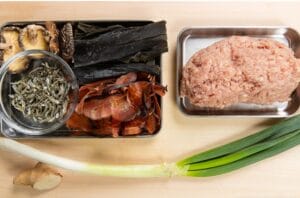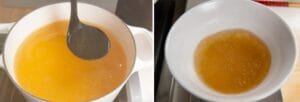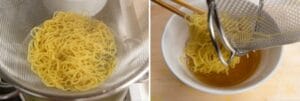Shio ramen features a clear, salt-based broth that perfectly complements the noodles and toppings. This light yet flavorful ramen is a Japanese favorite.
After tasting shio ramen at an authentic ramen shop during a recent trip to Japan, I was determined to try making it at home. I wanted to recreate that beautifully clear, umami-rich broth and the delightfully springy noodles.
Shio ramen is all about letting the essential flavors of the ingredients shine through. With its straightforward salt seasoning and lack of strong flavors like miso or soy sauce, it can be harder to make a flavorful broth. But I found that by using dried shiitake mushrooms and niboshi (dried baby sardines) to make the dashi stock, and slowly simmering everything to coax out the flavors, I was able to achieve a light yet intensely savory result.
The finished soup is the perfect canvas for the various colorful and textural toppings – slices of chicken chashu, seasoned bamboo shoots, soft-boiled eggs, and crisp negi. As you lift each spoonful of noodles to your mouth, you get an enticing whiff of the aromatic scallion oil. That first sip floods your palate with the sweet umami of bonito flakes followed by the mellow saltiness of the shio tare. It’s a beautifully balanced and soothing flavor experience that I’m excited to share on my blog. I hope my homemade shio ramen recipe inspires you to try making this Japanese favorite!
What flavor is shio ramen ?

Shio ramen is a culinary embodiment of subtlety and serenity, with its clear broth seasoned simply with salt to accentuate the natural flavors of its base. This light yet flavorful soup carries an understated salinity that comforts without overwhelming, akin to a soft sea breeze. It’s a dish that offers solace, akin to a cozy blanket on a breezy day, inviting diners to savor the quiet sophistication of its taste.
The dish’s elegance lies in its minimalism, allowing for a reflective appreciation of the nuanced flavors and the skill involved in crafting a fine broth. Toppings are sparingly added, ensuring they enhance rather than dominate the delicate balance of the soup. Shio ramen is ideal for those seeking respite in a meal that’s both heartwarming and soul-nourishing, celebrating the beauty found in the simplest of pleasures.
Best Shio Ramen Recipes
Shio ramen noodles uses a salt-based broth. It can be served with vegetables or meat. The broth is a pale yellow colour and can be a bit salty. Depending on the meat or fish used, the noodles can be seasoned with miso or shoyu. In addition to shio noodle broth, shio ramen is also seasoned with salt. Among the three main flavourings of ramen, shio ramen is one of the most popular.

Shio Ramen
Equipment
Ingredients
- ½ cup Shio Tare
- 5 cups Chicken Soup Basic Clear
- 1⅓ pounds noodles fresh, such as Chukasuimen
- 4 to 8 slices Chicken Chashu
- Negi
Instructions
- With all your ingredients ready to go, bring a large pot of water to a boil over medium-high heat.

- Heat your ramen bowls by filling them halfway with hot water. The bowls don’t need to be scalding, but they should be hot to the touch. Dump out the hot water and dry the bowls with some paper towels or a clean towel.

Ramen must be hot.
- Put the tare and soup in a medium saucepan. Mix and bring to a simmer over low heat.

- Cook the noodles in the large pot of boiling water. Ramen that has been cut to a standard thickness (about 1 mm) will cook in 1 to 2 minutes.

- About 30 seconds before the noodles are finished cooking, ladle the soup into the ramen bowls.

- Drain the noodles, taking care to shake off as much excess water as you can. Carefully place some noodles in each bowl of soup, keeping them tidy.

- Place a slice or two of chicken chashu and a sprinkle of negi neatly on the ramen. Serve immediately

Video
Notes
Noodles: Use 3 ounces of dried ramen noodles per bowl, preferably the thin, straight style.
Nutrition
© Food And Meal
This website provides approximate nutrition information for convenience and as a courtesy only. Nutrition data is gathered primarily from the Spoonacular Database, whenever available, or otherwise other online calculators.
Shio Ramen in a Pressure Cooker

First, I chop up some green onions, mushrooms, and soft boiled eggs to top the ramen later. The aroma from the fresh ingredients makes me happy. I put the broth ingredients like kombu and shiitake mushrooms in the pressure cooker first. Then I add the chicken and vegetables. It smells so good already!
Next comes the fun part – locking the lid and setting the timer. When I hear the steam escaping 10 minutes later, I’m thrilled because I know the tasty ramen is almost ready. I let the pressure come down naturally rather than rushing it. Patience pays off when the lid finally opens, and I’m hit with the most wonderful umami smell ever.
Shio ramen vs Shoyu ramen ?
Shio ramen, with its light and clear broth seasoned with salt, offers a subtle flavor that emphasizes the natural taste of its ingredients. It’s often associated with feelings of comfort and purity, providing a refreshing and soothing dining experience.
Shoyu ramen, on the other hand, features a soy sauce-infused broth that is darker and richer, delivering a robust and tangy taste. Its fermented depth brings warmth and can evoke nostalgia, especially for those who have long enjoyed it.
Some may favor shio ramen’s understated elegance and lighter touch, while others might be drawn to the umami richness of shoyu ramen. Both varieties are more than just food; they’re experiences that can stir emotions, offering comfort and a sense of well-being. The choice often hinges on one’s current mood or the setting, with shio being ideal for lighter fare and shoyu for when one desires something more hearty.
Tips for making Shio Ramen
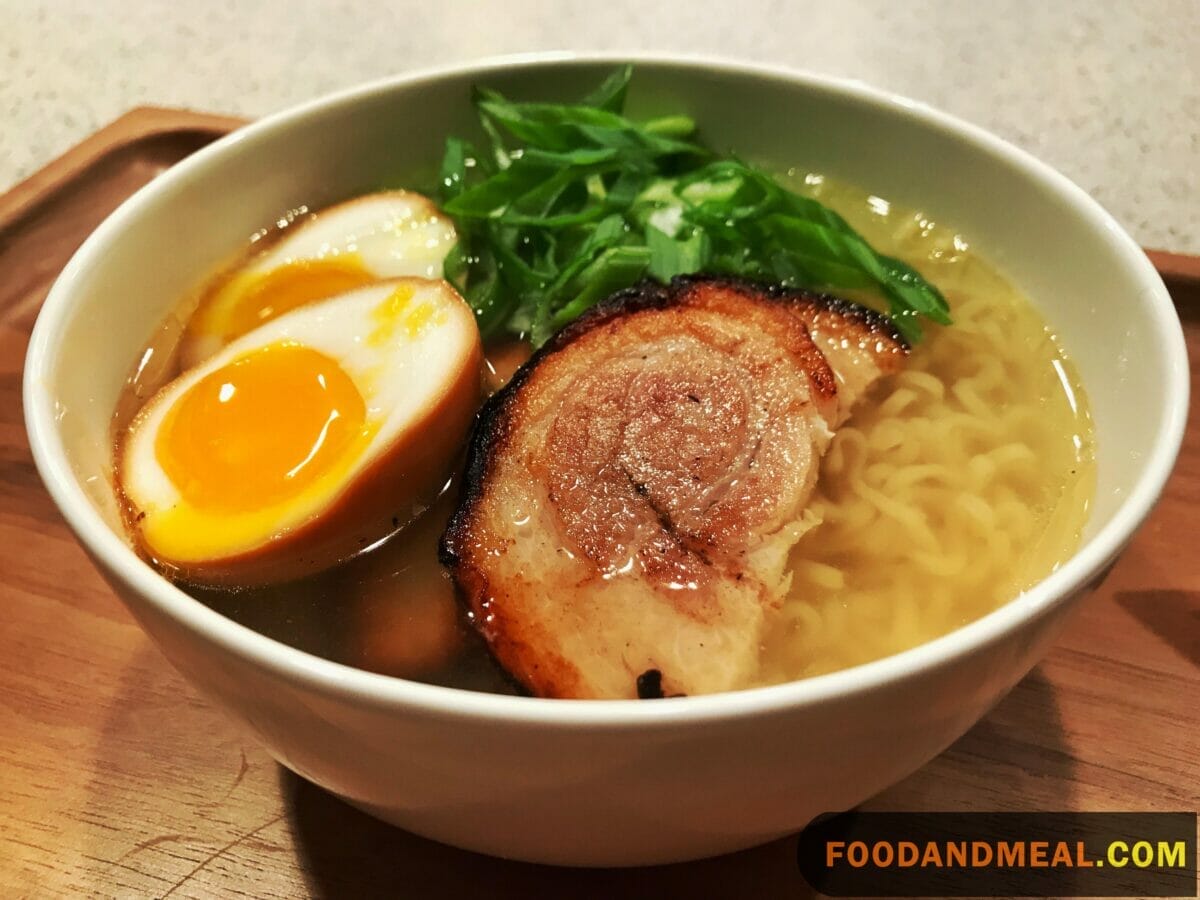
Serving Suggestions
Shio ramen is delicious on its own, but you can also serve it with some tasty side dishes:
- Gyoza – These Japanese pan-fried dumplings are the perfect accompaniment to ramen. The crispy skins with juicy, savory fillings like pork or chicken are a nice contrast to the brothy noodles.
- Karaage – These are Japanese fried chicken pieces that pair wonderfully with ramen. The crispy, seasoned exterior around the moist and tender chicken is hard to resist.
- Sashimi – For a lighter pairing, slices of raw fish like salmon or tuna sashimi go great with shio ramen. The clean flavors complement each other.
- Onigiri – Fluffy Japanese rice balls wrapped in nori seaweed make a nice addition to any ramen meal. They can be filled with salmon, tuna, pork, or even just salted plum for a burst of flavor.
- Miso soup – This traditional Japanese soup with dashi, tofu, and miso paste helps round out a shio ramen meal. Its salty umami notes balance the lighter broth.
Cooking Tips
I love the light, refreshing flavor of shio ramen. The clear broth is so clean and pure, it makes me feel calm and peaceful as I sip it. When cooking shio ramen at home, I’ve learned a few tips to really bring out that wonderful umami flavor.
Gently simmer the broth – boiling will make it cloudy. Skim off any scum too. Add dried sardines, kombu, and bonito flakes for extra umami. Their flavors infuse beautifully.
When it’s time to serve, I carefully arrange the toppings – slices of tender chicken chashu, bright menma bamboo shoots, wispy negi scallions. Simplicity is best with shio ramen, I think. I don’t want to cover up that lovely light broth!
A touch of aroma oil and shio tare sauce ties everything together. As I lift those first slippery noodles to my lips, I’m filled with anticipation of that perfect pure salty flavor.
FAQs about Shio Ramen
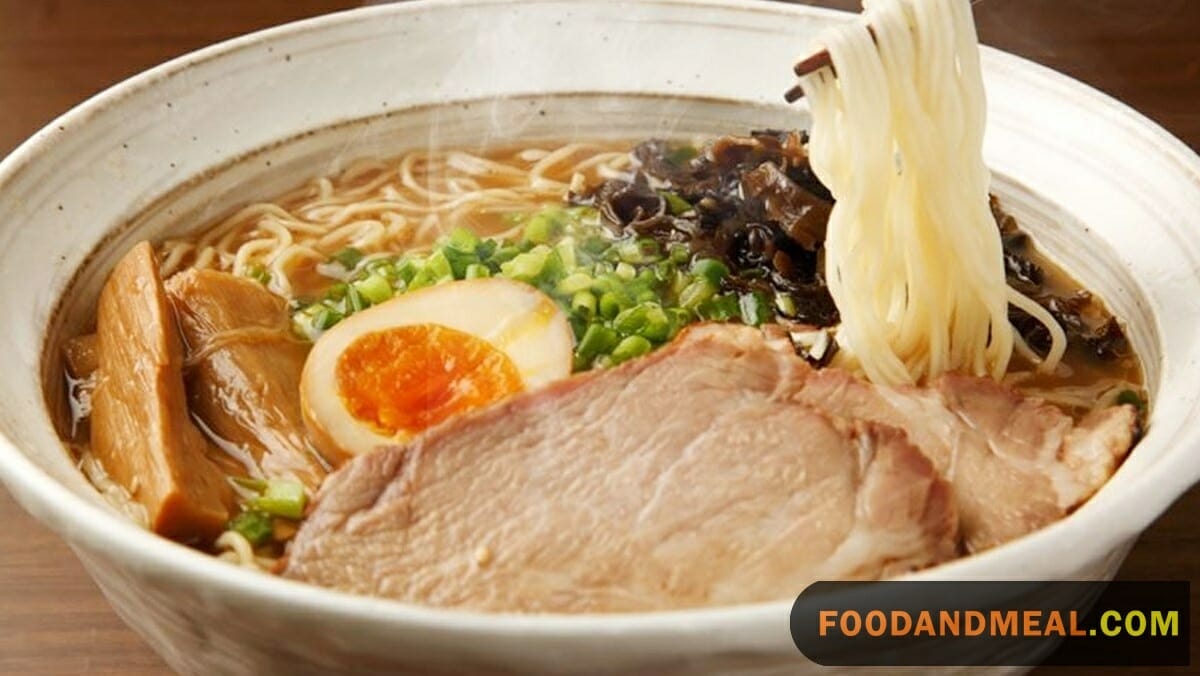
- What is shio ramen? Shio ramen is a Japanese noodle soup characterized by its clear and salty broth. The term “shio” translates to salt, highlighting the primary seasoning used in the broth. It typically features thin ramen noodles, along with toppings such as seaweed, green onions, and sliced pork.
- Is shio or shoyu ramen better? The preference between shio and shoyu ramen is subjective and depends on individual taste. Shio ramen has a clear, salt-based broth, while shoyu ramen features a soy sauce-based broth, providing a different flavor profile. Some may prefer the lighter taste of shio, while others enjoy the richer umami of shoyu.
- Is shio and tonkotsu the same? No, shio and tonkotsu ramen are different. Shio ramen has a clear, salt-based broth, while tonkotsu ramen has a rich and cloudy broth made from pork bones. The flavors and textures of these two ramen styles are distinct, with shio being lighter and tonkotsu being more hearty.
- Is shio ramen very salty? The saltiness of shio ramen can vary depending on the recipe and personal taste preferences. While it is salt-based, the saltiness is usually balanced to enhance the overall flavor without being overpowering.
- Can I store leftover Shio Ramen? Yes, you can store any remaining Shio Ramen in an airtight container in the refrigerator for up to 2 days. To reheat, use a microwave or stovetop, adding a little extra broth to maintain the consistency.
- Can I use other types of noodles for this recipe? Absolutely! While ramen noodles are traditional, you can experiment with udon or soba noodles for a unique twist. Just follow the package instructions for cooking.
- Can I make this recipe spicier? Certainly! Customize the spice level to your preference by adding chili oil, sriracha, or your favorite hot sauce to the finished bowl. Adjust the heat to suit your taste.
- What’s the difference between Shio Ramen and other ramen styles? Shio Ramen is characterized by its clear, salt-based broth. In contrast, other styles like Miso, Shoyu, and Tonkotsu use different bases (miso paste, soy sauce, and pork bone, respectively) for their broth, resulting in distinct flavors.
- Can I make a large batch in the pressure cooker? Yes, you can double or triple the ingredients to make a larger batch, but ensure that you don’t exceed the maximum fill line of your pressure cooker. Cooking times may need to be adjusted for larger quantities, so keep an eye on the pressure release valve and broth consistency.
Conclution
I hope this shio ramen recipe inspires you to try making this light and fragrant Japanese noodle soup at home. With its delicately flavored broth showcasing ingredients like kombu, bonito flakes, and niboshi, it’s a soothing and comforting meal that also happens to be healthy and easy to make.
Be sure to check FoodAndMeal.com for more authentic recipes and culinary inspiration from around the world. I try to share dishes that provide a little taste of places I’ve traveled to or cultures I’ve explored. But most importantly, I aim to give you recipes that will nourish your body and spirit.
Wishing you many happy and flavorful meals ahead! Please let me know in the comments if you try this shio ramen recipe or have any other Japanese dish requests for the blog.
I'm James F Anderson, a noted sous chef from London and a Le Cordon Bleu alumnus. My career began in a Michelin-starred Parisian eatery, where my blend of classic and contemporary cooking, using seasonal ingredients, earned accolades. Recognized in culinary publications and on cooking shows, I’m committed to mentoring aspiring chefs and delivering memorable dining experiences, marking me as a standout talent in the culinary world.




